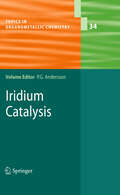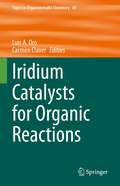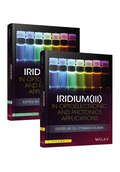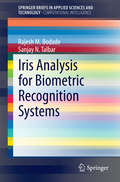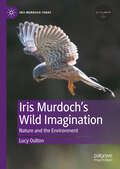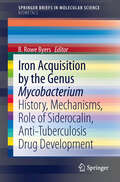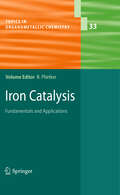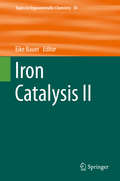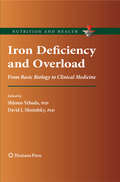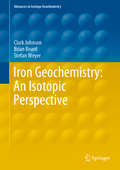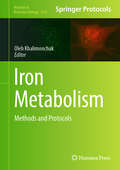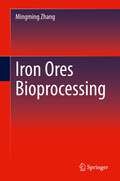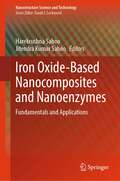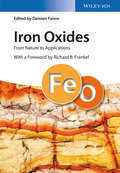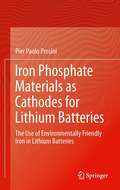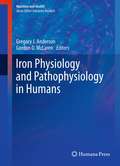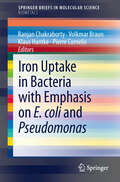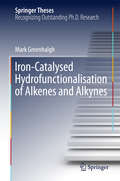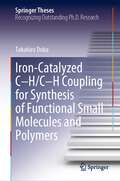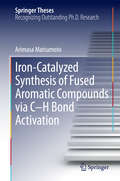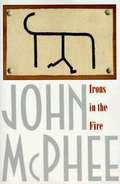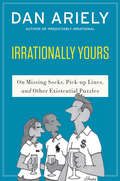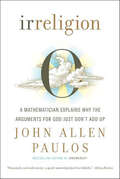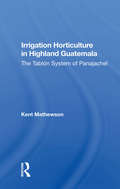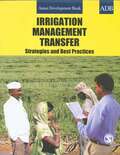- Table View
- List View
Iridium Catalysis
by Pher G. AnderssonFrom the contents: Robert H Crabtree: Introduction and History. - Montserrat Diéguez, Oscar Pàmies and Carmen Claver: Iridium-catalysed hydrogenation using phosphorous ligands. - David H. Woodmansee and Andreas Pfaltz: Iridium Catalyzed Asymmetric Hydrogenation of Olefins with Chiral N,P and C,N Ligands. - Ourida Saidi and Jonathan M J Williams: Iridium-catalyzed Hydrogen Transfer Reactions. - John F. Bower and Michael J. Krische: Formation of C-C Bonds via Iridium Catalyzed Hydrogenation and Transfer Hydrogenation. - Jongwook Choi, Alan S. Goldman: Ir-Catalyzed Functionalization of C H Bonds. - Mark P. Pouy and John F. Hartwig: Iridium-Catalyzed Allylic Substitution. - Daniel Carmona and Luis A. Oro: Iridium-catalyzed 1.3-dipolar cycloadditions.
Iridium Catalysts for Organic Reactions (Topics in Organometallic Chemistry #69)
by Carmen Claver Luis A. OroThis new volume “Iridium Catalysts for Organic Reactions” in the series “Topics in Organometallic Chemistry” intends to update several representative well-known reactions and to introduce other less known or new reactions in particular covering sustainability aspects. Iridium complexes are efficient in many catalytic homogeneous transformations providing high efficiency in both results, activity and selectivity. The interest of the book lies in the presentation of the advances, new perspectives and application in a variety of representative iridium-catalysed reaction. All chapters in the volume are contributed by relevant international experts in the field. The book is aimed at researchers, graduate students and synthetic chemists at all levels in academia and industry.
Iridium(III) in Optoelectronic and Photonics Applications
by Eli Zysman-ColmanThe fundamental photophysical properties of iridium(III) materials make this class of materials the pre-eminent transition metal complex for use in optoelectronic applications. Iridium(III) in Optoelectronic and Photonics Applications represents the definitive account of photoactive iridium complexes and their use across a wide variety of applications. This two-volume set begins with an overview of the synthesis of these complexes and discusses their photophysical properties. The text highlights not only mononuclear complexes but also the properties of multinuclear and polymeric iridium-based materials and the assembly of iridium complexes into larger supramolecular architectures such as MOFs and soft materials. Chapters devoted to the use of these iridium-based materials in diverse optoelectronic applications follow, including: electroluminescent devices such as organic light emitting diodes (OLEDs) and light-emitting electrochemical cells (LEECs); electrochemiluminescence (ECL); bioimaging; sensing; light harvesting in the context of solar cell applications; in photoredox catalysis and as components for solar fuels. Although primarily targeting a chemistry audience, the wide applicability of these compounds transcends traditional disciplines, making this text also of use to physicists, materials scientists or biologists who have interests in these areas.
Iris Analysis for Biometric Recognition Systems
by Rajesh M. Bodade Sanjay N. TalbarThe book presents three most significant areas in Biometrics and Pattern Recognition. A step-by-step approach for design and implementation of Dual Tree Complex Wavelet Transform (DTCWT) plus Rotated Complex Wavelet Filters (RCWF) is discussed in detail. In addition to the above, the book provides detailed analysis of iris images and two methods of iris segmentation. It also discusses simplified study of some subspace-based methods and distance measures for iris recognition backed by empirical studies and statistical success verifications.
Iris Murdoch’s Wild Imagination: Nature and the Environment (Iris Murdoch Today)
by Lucy OultonThis book presents the first ecocritical study of novelist, philosopher, poet and public intellectual Iris Murdoch (1919–1999). It brings her love of the natural world into the light, arguing for its critical significance when Murdoch conveys an awareness of intricately interconnected ecologies through her work: an awareness that anticipates the motivations and concerns of modern-day environmental humanities. The book is the first of its kind to assess some of Murdoch's poems, seen as early articulation of the environmental imagination that finds recurrent expression in her novels, philosophical writings and personal journals throughout her writing life. This book offers a significant entry point for a new research direction in Murdoch studies by explicating her unique perspective on the natural world.
Iron Acquisition by the Genus Mycobacterium
by B. Rowe ByersIron Acquisition by the Genus Mycobacterium summarizes the early evidence for the necessity of iron in mycobacteria and the discovery of the mycobacterial siderophores mycobactin, carboxymycobactin, and exochelin. The structural characterization of the mycobacterial siderophores is described. The genes so far identified as essential for iron acquisition and maintenance of an infection by pathogenic mycobacteria are discussed. The potential role of siderocalin in iron gathering by M. tuberculosis is featured. Because new drugs for M. tuberculosis are needed, this brief also emphasizes the design of antibiotics that interfere with siderophore biosynthesis and the use of siderophore analogs and/or conjugates.
Iron Catalysis
by Bernd PlietkerJuan I. Padrón and Víctor S. Martín: Catalysis by means of Fe-based Lewis acids; Hiroshi Nakazawa*, Masumi Itazaki: Fe-H Complexes in Catalysis; Kristin Schröder, Kathrin Junge, Bianca Bitterlich, and Matthias Beller: Fe-catalyzed Oxidation Reactions of Olefins, Alkanes and Alcohols: Involvement of Oxo- and Peroxo Complexes; Chi-Ming Che, Cong-Ying Zhou, Ella Lai-Ming Wong: Catalysis by Fe=X Complexes (X=NR, CR2); René Peters, Daniel F. Fischer and Sascha Jautze: Ferrocene and Half Sandwich Complexes as Catalysts with Iron Participation; Markus Jegelka, Bernd Plietker: Catalysis by Means of Complex Ferrates.
Iron Catalysis II
by Eike BauerThe series Topics in Organometallic Chemistry presents critical overviews of research results in organometallic chemistry. As our understanding of organometallic structure, properties and mechanisms increases, new ways are opened for the design of organometallic compounds and reactions tailored to the needs of such diverse areas as organic synthesis, medical research, biology and materials science. Thus the scope of coverage includes a broad range of topics of pure and applied organometallic chemistry, where new breakthroughs are being achieved that are of significance to a larger scientific audience. The individual volumes of Topics in Organometallic Chemistry are thematic. Review articles are generally invited by the volume editors.
Iron Deficiency and Overload
by David I. Mostofsky Shlomo YehudaIron deficiency is ever-present among all populations throughout the world irrespective of race, culture, or ethnic background. Even with the latest advances in medicine, improved nutrition, and the ready availability of cheap oral iron, there is still no satisfactory explanation for the widespread occurrence of iron deficiency or for the absence of an effective treatment. Iron Deficiency and Overload: From Biology to Clinical Medicine is an important new text that provides a timely review of the latest science concerning iron metabolism as well as practical, data-driven options to manage at-risk populations with the best accepted therapeutic nutritional interventions. Chapter topics reflect the excitement in current theoretical development and laboratory activity in this area. The distinguished authors address their presentations to professionals and graduate students who need to be better informed about the concepts, methodologies, and current status of the field. Iron Deficiency and Overload: From Biology to Clinical Medicine is an essential text that presents a sampling of the major issues in iron research, from the most basic research level to human applications.
Iron Geochemistry: An Isotopic Perspective (Advances in Isotope Geochemistry)
by Clark Johnson Brian Beard Stefan WeyerThis book provides a comprehensive summary of research to date in the field of stable iron isotope geochemistry. Since research began in this field 20 years ago, the field has grown to become one of the major research fields in "non-traditional" stable isotope geochemistry. This book reviews all aspects of the field, from low-temperature to high-temperature processes, biological processes, and cosmochemical processes. It provides a detailed history and state-of-the art summary about analytical methods to determine Fe-isotope ratios and discusses analytical and sample prospects.
Iron Metabolism: Methods and Protocols (Methods in Molecular Biology #2839)
by Oleh KhalimonchukThis detailed volume explores classical and cutting-edge methods optimized and validated to analyze various aspects of iron metabolism, from in vitro to multi-organ level. Opening with a section on basic iron metabolism methods, the book continues with methods applicable to a variety of systems, ranging from bacteria to cultured mammalian cells and tissues, with a focus on cellular heme and iron-sulfur cluster species, as well as mitochondrial iron and its derivatives. Written for the highly successful Methods in Molecular Biology series, chapters include introductions to their respective topics, lists of the necessary materials and reagents, step-by-step and readily reproducible laboratory protocols, and tips on troubleshooting and avoiding known pitfalls. Authoritative and practical, Iron Metabolism: Methods and Protocols serves as an ideal guide for researchers seeking to help in demystifying and boosting iron metabolism-related research.
Iron Ores Bioprocessing
by Mingming ZhangThis book describes leading research in bioengineering for development of novel technologies for ferrous metal extraction. The author includes new developments in molecular biology, biochemistry, microbiology, cell metabolism, and engineering principles and applies them to the conventional iron ore industry - proposing innovative solutions to various industry challenges. The book focuses on applied approaches and describes emerging and established industrial processes, as well as the underlying theory of the process, and the biology of the microorganisms involved.Elaborates on bioprocessing technologies applicable for extraction of ferrous metals using cross-pollination of microbiology and extractive metallurgy;Presents a systematic overview of bioprocessing technologies encompassing laboratory research, pilot scale studies, and industrial process flowsheet design;Provides comprehensive coverage of the engineering principles behind bioprocesses of iron ores including material and energy balances, transport processes, reactions and reactor engineering.
Iron Oxide-Based Nanocomposites and Nanoenzymes: Fundamentals and Applications (Nanostructure Science and Technology)
by Harekrushna Sahoo Jitendra Kumar SahooThis contributed volume provides a comprehensive understanding of synthetic protocols, characterization techniques, and current applications of iron oxide-based nanocomposite and nanoenzyme materials. It covers basic concepts and recent advancements in iron oxide-based nanocomposites and nanoenzymes, focusing on their synthesis, characterization, and functionalization for specific research applications. The different chapters in the book highlight key characterization techniques including Fourier Transform Infrared Spectroscopy, X-ray diffraction, Scanning Electron Microscopy, and Transmission Electron Microscopy, among others while it also explores various applications of these materials, such as adsorption of heavy metals and dyes, gas sensors, biomedical applications, photo-catalysis, and photovoltaic sensors. This book serves as a valuable resource for researchers and graduate students working in the fields of materials science, chemistry, physics, and biotechnology.
Iron Oxides: From Nature to Applications
by Damien Faivre Richard B. FrankelThis handbook and ready reference covers all important aspects of the information available on iron oxides. A preliminary overview chapter discusses iron oxide minerals with their unique structures and properties, before the following section goes on to deal with the formation and transformation of iron oxides, covering geological, synthetic, medical, and microbiological as well as physico-chemical aspects. A chapter on corrosion from a chemical engineering viewpoint completes this section. Subsequent chapters are devoted to characterization techniques. Besides such classical methods as IR/Raman and Mössbauer spectroscopy, special attention is focused on X-ray based techniques, magnetic measurements, and electron microscopy for structural characterization. The final section is mainly devoted to exciting new applications of magnetic iron oxides, for example, in medicine. Additional chapters on geo/paleomagnetism, environmental aspects, and pigments illustrate the full scope of applications. A must-read for anyone working in the field.
Iron Phosphate Materials as Cathodes for Lithium Batteries
by Pier Paolo ProsiniIron Phosphate Materials as Cathodes for Lithium Batteries describes the synthesis and the chemical-physical characteristics of iron phosphates, and presents methods of making LiFePO4 a suitable cathode material for lithium-ion batteries. The author studies carbon's ability to increase conductivity and to decrease material grain size, as well as investigating the electrochemical behaviour of the materials obtained. Iron Phosphate Materials as Cathodes for Lithium Batteries also proposes a model to explain lithium insertion/extraction in LiFePO4 and to predict voltage profiles at various discharge rates. Iron Phosphate Materials as Cathodes for Lithium Batteries is written for postgraduate students and researchers in electrochemistry, R&D professionals and experts in electrochemical storage.
Iron Physiology and Pathophysiology in Humans
by Gordon D. Mclaren Gregory J. AndersonIron Physiology and Pathophysiology in Humans provides health professionals in many areas of research and practice with the most up-to-date and well-referenced volume on the importance of iron as a nutrient and its role in health and disease. This important new volume is the benchmark in the complex area of interrelationships between the essentiality of iron, its functions throughout the body, including its critical role in erythropoiesis, the biochemistry and clinical relevance of iron-containing enzymes and other molecules involved in iron absorption, transport and metabolism, he importance of optimal iron status on immune function, and links between iron and the liver, heart, brain and other organs. Moreover, the interactions between genetic and environmental factors and the numerous co-morbidities seen with both iron deficiency and iron overload in at risk populations are clearly delineated so that students as well as practitioners can better understand the complexities of these interactions. Key features of the volume include an in-depth index and recommendations and practice guidelines are included in relevant chapters. The volume contains more than 100 detailed tables and informative figures and up-to-date references that provide the reader with excellent sources of information about the critical role of iron nutrition, optimal iron status and the adverse clinical consequences of altered iron homeostasis. Iron Physiology and Pathophysiology in Humans is an excellent new text as well as the most authoritative resource in the field.
Iron Uptake in Bacteria with Emphasis on E. coli and Pseudomonas
by Volkmar Braun Klaus Hantke Pierre Cornelis Ranjan ChakrabortyIron is essential for the growth of most bacteria because it serves as a cofactor for vital enzymes and for the components of the electron transport chain. Moreover, Iron plays an important role in bacterial pathogenicity; in fact, the iron transport systems in bacteria works as target for designing novel antibiotics. Because iron is not soluble under aerobic conditions, bacteria have had to find ways to overcome iron deficiency. One of them is producing an iron-chelating small organic molecule called siderophore. Indeed, most bacteria and fungi produce structurally and chemically diverse siderophores which are transported back to the cytoplasm using complex energy dependent transport systems. Escherichia coli and Pseudomonas were the first ones to be tested; however, nowadays iron transport systems have been investigated in many other bacteria. Iron Uptake in Bacteria with Emphasis on E. coli and Pseudomonas reviews the recent advancements in the field of iron transport systems in bacteria. Chapter 1 is dedicated to Dr. Dick van der Helm's contribution to the field of siderophore biology. It then describes and discusses the structural advances in the components and the mechanism of siderophore mediated iron transport systems in E.coli. Chapter 2 details the variety of iron transport and iron regulatory systems of both gram negative and gram positive bacteria. Finally, chapter 3 describes the iron transport systems of Pseudomonas. This book is aimed at researchers in the fields of iron metabolism in multiple organisms, and to those who are interested in studying iron transport systems of bacteria. It appeals also to scientists researching structure and function relationship of proteins.
Iron-Catalysed Hydrofunctionalisation of Alkenes and Alkynes
by Mark GreenhalghThisthesis gives a thorough account of the development of iron-catalysedhydrosilylation, hydroboration and hydromagnesiation reactions. Withextraordinary referencing and scientific argument, Mark Greenhalgh describesthe development of methodologies which require only commercially availablematerials and non-specialised techniques. The intention of this approach is toensure the science can be adopted widely by the chemical community. In additionto an insight into the processes involved in methodology development, Greenhalghdiscusses and determines the relevant reaction mechanisms. This thesis providesnot only the most thorough review of the area, but offers a level of insightwell beyond that expected from a Ph. D. student. The work in this thesis hasbeen published at the highest level, and the results and ideas have led to 3industry-funded Ph. D. studentships and grant income in excess of £1 million.
Iron-Catalyzed C-H/C-H Coupling for Synthesis of Functional Small Molecules and Polymers (Springer Theses)
by Takahiro DobaThis thesis describes the development of iron-catalyzed thienyl C–H/C–H coupling. This is applied to the synthesis of highly conjugated and electron-rich thiophene compounds of interest in materials science by utilization of low redox potential of iron in combination with a mild oxalate oxidant.Transition-metal-catalyzed C(sp2)–H/C(sp2)–H coupling has attracted much attention as one of the most straightforward methods to construct C(sp2)–C(sp2) bonds. However, application of this ideal transformation to the synthesis of redox-sensitive pi-materials was hindered by the requirement of a strong oxidant for catalyst turnover. This limitation originates primarily from the large redox potential of conventional transition-metal catalysts such as palladium and rhodium. This thesis shows that the efficiency of C–H activation was significantly improved by introduction of a new conjugated tridentate phosphine ligand, giving direct access to polymeric thiophene materials from simple thiophene monomers. Considering the importance of environmentally friendly organic synthesis in terms of UN Sustainable Development Goals, the reactions described herein highlight the potential of iron, the most abundant transition-metal on earth, for the direct synthesis of functional small molecules and polymers of importance in energy device applications.
Iron-Catalyzed Synthesis of Fused Aromatic Compounds via C-H Bond Activation
by Arimasa MatsumotoIron catalysts in organic synthesis are strongly in demand because iron is non-toxic, inexpensive and the most abundant transition metal in the earth, although their use is still limited compared with that of rare, precious metals such as palladium, ruthenium and rhodium. This thesis describes the first practical example of iron catalysis in the carbon-hydrogen bond activation reaction to synthesized fused aromatic ring compounds. By using a unique combination of iron catalyst and dichloride oxidant, various kind of naphthalene and phenanthrene derivatives were synthesized via annulation reaction with alkynes including direct C-H bond activation process. This achievement opens the new possibility of low-valent iron catalysis and expands synthetic methods for a sustainable society.
Irons in the Fire
by John McpheeAnother of McPhee's anthologies of well-written, highly informed, and very enjoyable essays that originally appeared in the New Yorker magazine. Joihn McPhee has a talent for making any subject interesting, and the diversity of the subjects he shares with his readers just in this book is astounding - from branding cattle to mountains made of tires to forensic geology to Plymouth Rock, and more.
Irrationally Yours: On Missing Socks, Pickup Lines, and Other Existential Puzzles
by Dr Dan Ariely William HaefeliNew York Times bestselling author Dan Ariely teams up with legendary New Yorker cartoonist William Haefeli to present an expanded, illustrated anthology of his immensely popular Wall Street Journal advice column, "Ask Ariely."Social scientist Dan Ariely revolutionized the way we think about ourselves, our minds, and our actions in his books Predictably Irrational, The Upside of Irrationality, and The (Honest) Truth About Dishonesty. Ariely applies this scientific analysis of the human condition in his "Ask Ariely" Q&A column in the Wall Street Journal, in which he responds to readers who write in with personal conundrums, ranging from the serious to the curious. What can you do to stay calm when you're playing the volatile stock market? What's the best way to get someone to stop smoking? How can you maximize the return on your investment at an all-you-can-eat buffet? Is it possible to put a price on the human soul? Can you ever rationally justify spending thousands of dollars on a Rolex?With their trademark insight and wit, Ariely and Haefeli help us reflect on how we can reason our way through external and internal challenges. Readers will laugh, learn, and, most important, gain a new perspective on how to deal with the inevitable problems that plague daily life.
Irreligion: A Mathematician Explains Why the Arguments for God Just Don't Add Up
by John Allen PaulosA lifelong unbeliever finds no reason to change his mind: “A good-natured primer for infidels” from the bestselling author of Innumeracy (Kirkus Reviews).Are there any logical reasons to believe in God? Mathematician and bestselling author John Allen Paulos thinks not. In Irreligion he presents the case for his own worldview, organizing his book into twelve chapters that refute the twelve arguments most often put forward for believing in God’s existence. The latter arguments, Paulos relates in his characteristically lighthearted style, “range from what might be called golden oldies to those with a more contemporary beat. On the playlist are the first cause argument, the argument from design, the ontological argument, arguments from faith and biblical codes, the argument from the anthropic principle, the moral universality argument, and others.” Interspersed among his twelve counterarguments are remarks on a variety of irreligious themes, ranging from the nature of miracles and creationist probability to cognitive illusions and prudential wagers. Special attention is paid to topics, arguments, and questions that spring from his incredulity “not only about religion but also about others’ credulity.” Despite the strong influence of his day job, Paulos says, there isn’t a single mathematical formula in the book.“He’s done it again. John Allen Paulos has written a charming book that takes you on a sojourn of flawless logic, with simple and clear examples drawn from math, science, and pop culture. At journey’s end, Paulos has left you with plenty to think about, whether you are religious, irreligious, or anything in between.” —Neil deGrasse Tyson
Irrigation Horticulture In Highland Guatemala: The Tablon System Of Panajachel
by Kent MathewsonNew evidence that the ancient Mayas practiced intensive, often irrigated, agriculture on a massive scale has forced revision in current thinking about that civilization. Yet, little study has focused on the heirs of this agricultural tradition; in areas of highland Guatemala, Mayan farmers today carry on forms of intensive, irrigated horticulture t
Irrigation Management Transfer: Strategies and Best Practices
by Asian Development BankOver the years, various factors like increased competition for water, fiscal constraints faced by the government in continued subsidies for irrigation management, the demonstrated improvement in water use equity and efficiency when managed by the users, have led to the devolution of irrigation management to users. Irrigation Management Transfer (IMT), that is, the relocation of responsibility and authority for irrigation management from government agencies to the users, such as water users′ associations, has been adopted in more than 25 countries across the world. However, its implementation and adaptation across and within countries has been varied and is at different stages of development. This work, supported by the Asian Development Bank (ADB), New Delhi, is a synthesis of strategies and best practices adopted by various countries with respect to IMT. It identifies key concerns such as the structure and functions of water users′ associations, financial mobilization and constraints, repair and maintenance of physical structures, operation of canal systems and capacity building and monitoring mechanisms. It also identifies enabling environments, including regulatory mechanisms and the role of non-governmental organizations. The last section of this volume distils critical issues and strategic options and suggests a way forward. It is largely based on secondary sources, although some field-based studies and visits were carried out across various states in India.
